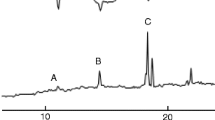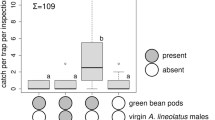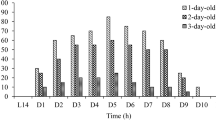Abstract
Adult males ofSemiothisa signaria dispuncta (Walker) were attracted to field traps baited with (Z,Z,Z)-3,6,9-octadecatriene and (Z,Z)-6,9-cis-3,4-epoxy-octadecadiene. However, analyses of sex pheromone gland extracts of females of this species by GC-MS and by GC in combination with an electroantennograph detector (GC-EAD) showed the pheromone to be comprised of a mixture of the next lower homologs: (Z,Z,Z)-3,6,9-heptadecatriene and (Z,Z)-6,9-cis-3,4-epoxy-heptadecadiene. Blends of these two C17 compounds were subsequently found to be more attractive to males in the field than the corresponding C18 mixtures. Sex pheromones of two otherSemiothisa species were also found to contain C17 components. (Z,Z,Z)-3,6,9-Heptadecatriene, detected by GC-EAD analysis of a female abdominal tip extract ofS. bicolorata (Fabricius), attracted conspecific males, and this attraction was significantly reduced by additions of (Z,Z)-6,9-cis-3,4-epoxyheptadecadiene, the major pheromone component ofS. signaria dispuncta, to the lure. (Z,Z)-3,9-cis-6,7-Epoxy-heptadecadiene was detected by GC-EAD analysis as the primary male antennal stimulatory component present in abdominal tip extracts ofS. ulsterata (Pearsall), and males of this species were attracted to traps baited with this epoxide. Each of these three C17 compounds constitute previously unknown lepidopteran sex pheromone components. Blends of (Z,Z, Z)-3,6,9-heptadecatriene and (Z,Z)-3,9-cis-6,7-epoxyheptadecadiene attracted males of a fourth species,S. delectata Hulst, but no females of this species were obtained to permit analysis of its sex pheromone. The occurrence of (Z,Z,Z)-3,6,9-heptadecatriene inS. neptaria (Guenee) females was indicated by GC-MS analysis of an abdominal tip extract; however, no males were attracted to any of the fielded mixtures containing this hydrocarbon.
Similar content being viewed by others
References
Arn, H., Stadler, E., andRauscher, S. 1975. The electroantennographic detector—a selective and sensitive tool in the gas Chromatographic analysis of insect pheromones.Z. Naturforsch. 30c:722–725.
Brown, H.C., Mandal, A.K., andKulkarni, S.U. 1977. Hydroboration. 45. New, convenient preparations of representative borane reagents utilizing borane-methyl sulfide.J. Org. Chem. 42:1392–1398.
Chisholm, M.D., Steck, W.F., Arthur, A.P., andUnderhill, E.W. 1975. Evidence forcis-11-hexadecen-1-ol acetate as a major component of the sex pheromone of the bertha army-worm,Mamestra configurata (Lepidoptera: Noctuidae).Can. Entomol. 107:361–366.
Duncan, D.B. 1955. Multiple range and multiple F tests.Biometrics 11:1–41.
Ferguson, D.C. 1974. Moths of theSemiothisa signaria complex (Lepidoptera: Geometridae).Can. Entomol. 106:569–621.
Garnero, J., andJoulain, D. 1981. Constituants volatils odorants et autres de l'essence absolut de feuilles et tiges de tomate.Riv Ital. EPPOS 63:361–364.
Underhill, E.W., Palaniswamy, P., Abrams, S.R., Bailey, B.K., Steck, W.F., andChisholm, M.D. 1983. Triunsaturated hydrocarbons, sex pheromone components ofCaenurgina erechtea.J. Chem. Ecol. 9:1413–1423.
Underhill, E.W.,Millar, J.G., andWong, J.W. 1985. Unsaturated hydrocarbons and their oxygenated analogs as a major class of lepidopteran sex attractants. Entomological Society of America National Meeting, December 1985. Hollywood, Florida.
Wong, J.W., Underhill, E.W., Mackenzie, S.L., andChisholm, M.D. 1985. Sex attractants for geometrid and noctuid moths. Field trapping and electroantennographic responses to triene hydrocarbons and monoepoxydiene derivatives.J. Chem. Ecol. 11:727–756.
Author information
Authors and Affiliations
Rights and permissions
About this article
Cite this article
Millar, J.G., Underhill, E.W., Giblin, M. et al. Sex pheromone components of three species ofSemiothisa (Geometridae), (Z,Z,Z)-3,6,9-heptadecatriene and two monoepoxydiene analogs. J Chem Ecol 13, 1371–1383 (1987). https://doi.org/10.1007/BF01012284
Received:
Accepted:
Issue Date:
DOI: https://doi.org/10.1007/BF01012284




